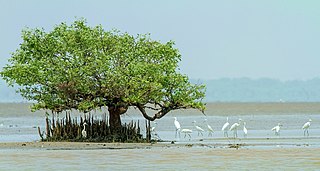
Coringa Wildlife Sanctuary is a wildlife sanctuary and estuary situated near Kakinada in Andhra Pradesh, India. It is the second largest stretch of mangrove forests in India with 24 mangrove tree species and more than 120 bird species. It is home to the critically endangered white-backed vulture and the long billed vulture. In a mangrove ecosystem the water bodies of the ocean/sea and the river meet together at a certain point.

Suaeda is a genus of plants also known as seepweeds and sea-blites. Most species are confined to saline or alkaline soil habitats, such as coastal salt-flats and tidal wetlands. Many species have thick, succulent leaves, a characteristic seen in various plant genera that thrive in salty habitats.
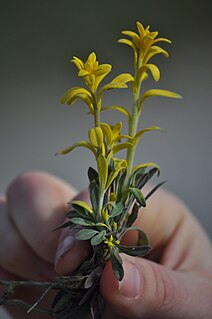
Puccinia monoica is a parasitic rust fungus of the genus Puccinia that inhibits flowering in its host plant and radically transforms host morphology in order to facilitate its own sexual reproduction.

Suaeda australis, the austral seablite, is a species of plant in the family Amaranthaceae, native to Australia. It grows to between 0.1 and 0.9 metres in height, with a spreading habit and branching occurring from the base. The leaves are up to 40 mm in length and are succulent, linear and flattened. They are light green to purplish-red in colour.
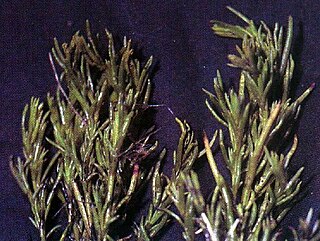
Suaeda calceoliformis is a species of flowering plant in the family Amaranthaceae known by several common names, including Pursh seepweed and horned seablite.

Suaeda californica is a rare species of flowering plant in the amaranth family known by the common name California seablite. It is endemic to San Luis Obispo County, California, where it is known from a few occurrences in the marshes around Morro Bay.

Suaeda nigra, often still known by the former name Suaeda moquinii, is a species of flowering plant in the amaranth family, known by the vernacular names bush seepweed or Mojave sea-blite.
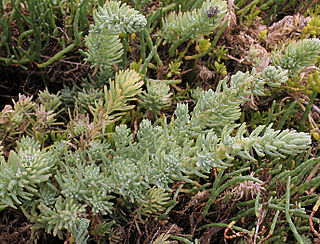
Suaeda taxifolia is a species of flowering plant in the family Amaranthaceae known by the common name woolly seablite.

Suaeda vera, also known as shrubby sea-blite, shrubby seablight or in the USA sometimes as alkali seepweed, is a species of flowering plant in the family Amaranthaceae. It is a small shrub, with very variable appearance over its wide range. It is a halophyte, and occurs in arid and semi-arid saltflats, salt marshes and similar habitats.
Suaeda maritima is a species of flowering plant in the family Amaranthaceae known by the common names herbaceous seepweed and annual seablite.

Suaeda aegyptiaca is a species of succulent plant in the family Amaranthaceae, and salt-tolerant (halophyte) plant that is distributed in eastern North Africa, the Near East and West Asia.

Suaeda fruticosa is a species of flowering plant in the family Amaranthaceae. It is a small shrub, with very variable appearance over its wide range. It is a halophyte, and occurs in arid and semi-arid saltflats, salt marshes and similar habitats.
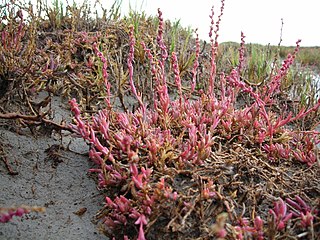
Suaeda pulvinata is an endemic seepweed from Mexico. It lives in the shores of Lake Texcoco and Lake Totolcingo. It lives underwater as an aquatic plant for half of the year and in dry land as a terrestrial plant for the other half due to the changing levels of the lakes that it inhabits. It is a perennial flat herb with prostrate stems. Its leaves and inflorescences are green to reddish in color.
Juncus rigidus is a species of rush known by the common name sea rush. It is native to much of Africa and parts of western Asia. It is found inland and by the sea in sandy saline habitats.

Tamarix usneoides, locally known as wild tamarisk, is a twiggy shrub or small evergreen tree that grows in saline habitats, semi-deserts and karroid areas in southern Africa. It has a short trunk, thin branches usually growing from ground level, tiny scale-like leaves and spikes of creamy-white flowers.

Aeluropus lagopoides, sometimes called mangrove grass or rabbit-foot aeluropus, is a species of Eurasian and African plant in the grass family, found primarily in salty soils and waste places.
Grevillea pythara, also known as the Pythara grevillea, is a shrub of the genus Grevillea native to a small area in the Wheatbelt region of Western Australia.
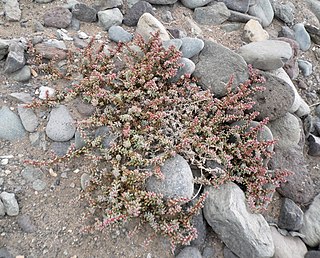
Suaeda vermiculata is a species of plant in the family Amaranthaceae. It is a salt-tolerant plant (halophyte) that grows naturally in salt-affected areas.

The Yellow Sea saline meadow ecoregion covers a thin strip of wetlands between the Shandong Peninsula and the mouth of the Yangtze River on the coast of the East China Sea. The plants of the region are adapted to the wet, saline soils transitioning inland to fresh water arriving from the west. The area is an important stop-over on the East Asian–Australasian Flyway. The region is under heavy ecological pressure from human development and agriculture.

Bienertia cycloptera is a species of flowering plant that is native to the Middle East, south-eastern Europe, and central Asia. It is a succulent, smooth annual plant with long, curved, cylindrical leaves. Its flowers have both male and female reproducing parts and its fruits are small and spherical. Bienertia cycloptera grows in hot, dry climates with little rainfall and tolerates soils with high salinity levels very well. Due to its specific growing conditions, B. cycloptera is not a very common, nor widespread plant. Even over most of its range, it often grows sparsely in small patches of growth. One notable aspect of Bienertia cycloptera is its unique C4 photosynthesis mechanism. Unlike most C4 plants, in B. cycloptera the photosynthetic mechanism occurs within a single chlorenchyma cell, without Kranz anatomy.
















